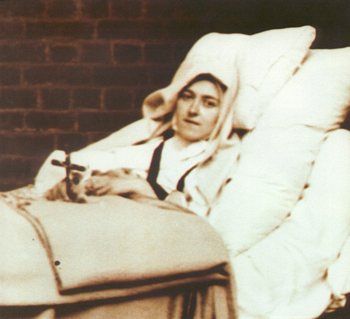The Divine Office for this memorial of St Therese of Lisieux is the Common for Virgins.
On coming into the Catholic Church I was at first somewhat flummoxed by this traditional veneration of virgins. It was not a feature of Anglicanism, and it was certainly not a feature of Evangelical Protestantism.
I was somewhat suspicious at first, but remembering my favorite dictum by the Anglican F.D.Maurice that “a man is most often right in what he affirms and wrong in what he denies” I thought it worthwhile to ponder this veneration of virgins a bit further, and as usual, this opening of the mind and heart has, over the years, been very beneficial.
So what is the point of venerating these virgins? And of course St Therese and other holy nuns are not the only ones. The stars in this constellation are the early Roman virgin martyrs” St Cecilia, St Agnes, St Agatha, St Lucy–and the modern St Maria Goretti. What’s the point? Is this simply the Catholic version of “Thank Heaven for Little Girls?” Is it no more than a sentimental exercise in weeping over young women who died tragically? Worse–is it the usual canard of “Catholics just hate sex. That’s why they venerate virgins.”
There is more to it than meets the eye. Firstly, to value this veneration of virgins we should define “virginity”. Virginity is more than simply not having had sexual intercourse. That would be a negative definition–like defining a person from Iowa as “someone who has never been to Paris, France.” The person from Iowa is more than the things he has never done. No. To be a virgin is to be virginal, to be wholly natural and innocent. We speak of a “Virgin forest” not only as a place where the trees have not been cut down, but also as a place of primeval innocence–a kind of Eden that has not been corrupted and soiled. When we speak of a saint being “virginal” we are referring to her whole character. She is pure and innocent and whole in body, mind and spirit.
Why, you might ask, is it only young women who are venerated as virgins? May not a young man’s virginity and innocence also be honored? Yes, it may, but there is a different biology involved. The female body is, by its nature, enclosed and guarded. There is an inner sanctum of the womb which is hidden and inviolate in a way that a young man’s body is not. To be blunt, his masculine organs are on the outside. Hers on the inside. His are designed for penetration. Hers are designed for reception. Therefore the biological facts provide a kind of symbol of virginity. It is something hidden and inviolate–something precious and preserved from penetration. The man’s body does not carry or communicate the same symbolism.
In venerating the virgin saints we also venerate the Queen of Virgins, the Blessed Virgin Mary. She epitomizes the virtues of virginity completely. As the second Eve she completes the restoration of virginity and through her prayers her Son empowers the restoration of virginity to a race soiled and spoiled by sin.
As we venerate the virgins we therefore pray for the restoration of virginity, for while it is true that virginity, once lost seems like it can never be restored, in fact through the redemptive work of Christ on the cross the original virginity of mankind can be restored. When we are baptized (and after we have made a full confession) that primal virginity of soul is restored. The wonder of this is that the restored virginity is actually better than the original virginity. How can this be? Because mankind, having fallen, goes through the risk and rebellion of sin, but through that battle he comes out the other side. Through the victory of redemption mankind comes out of the tunnel of depravity and darkness into the light a Eden restored–a virginity and childhood that is greater than the primal innocence because, through the drama of the fall and rescue, the darkness has defeated. This second virginity is fuller and more complete than the first for it holds within itself a battle fought, a victory won and a destiny restored.
Read my book St Benedict and St Therese–The Little Rule and the Little Way and check out Stronger Than Steel the wonderful collection of letters from young French soldiers in the First World War recounting their supernatural encounters with St Therese on the battlefield. Go here:







Leave A Comment
You must be logged in to post a comment.